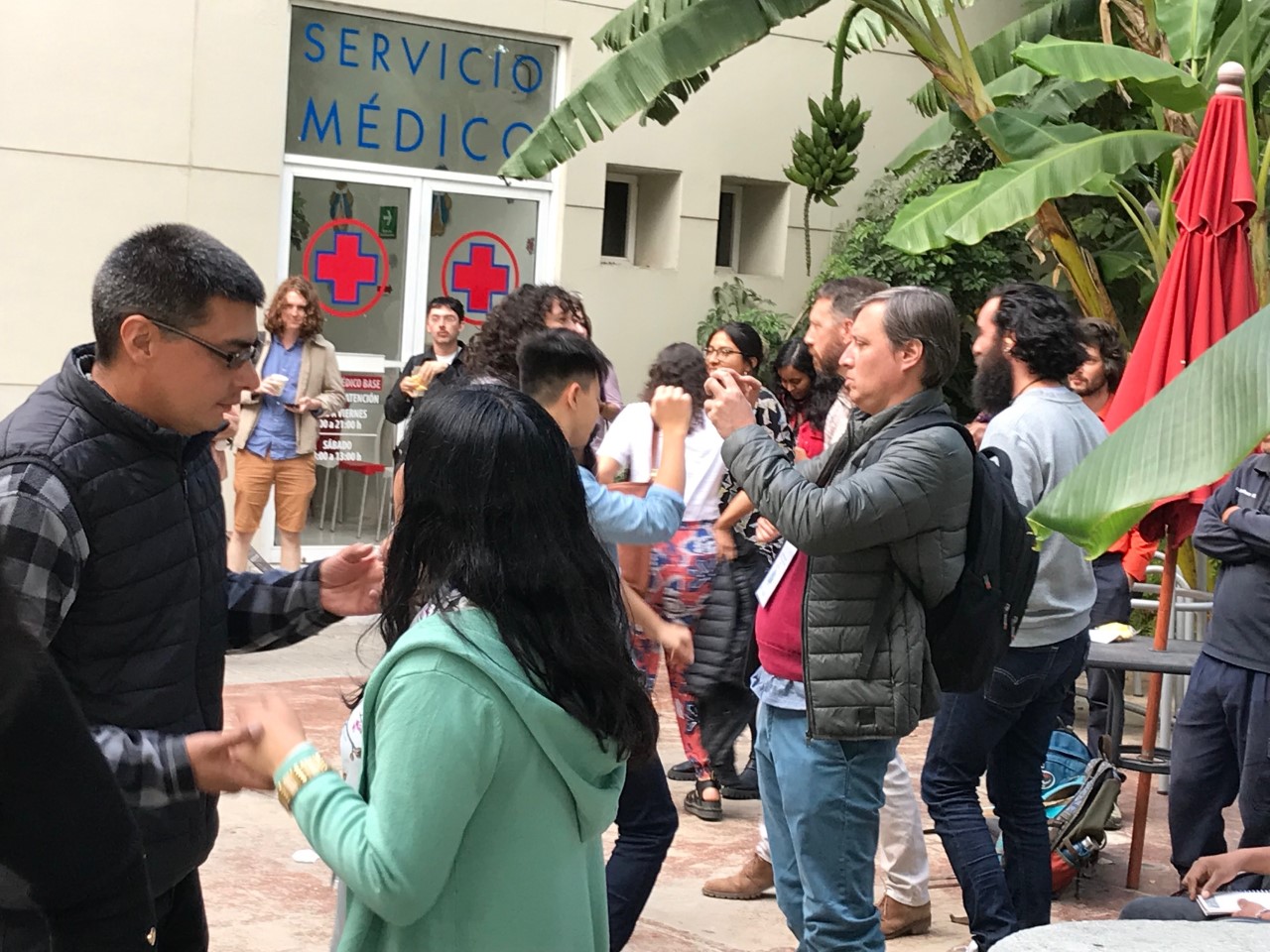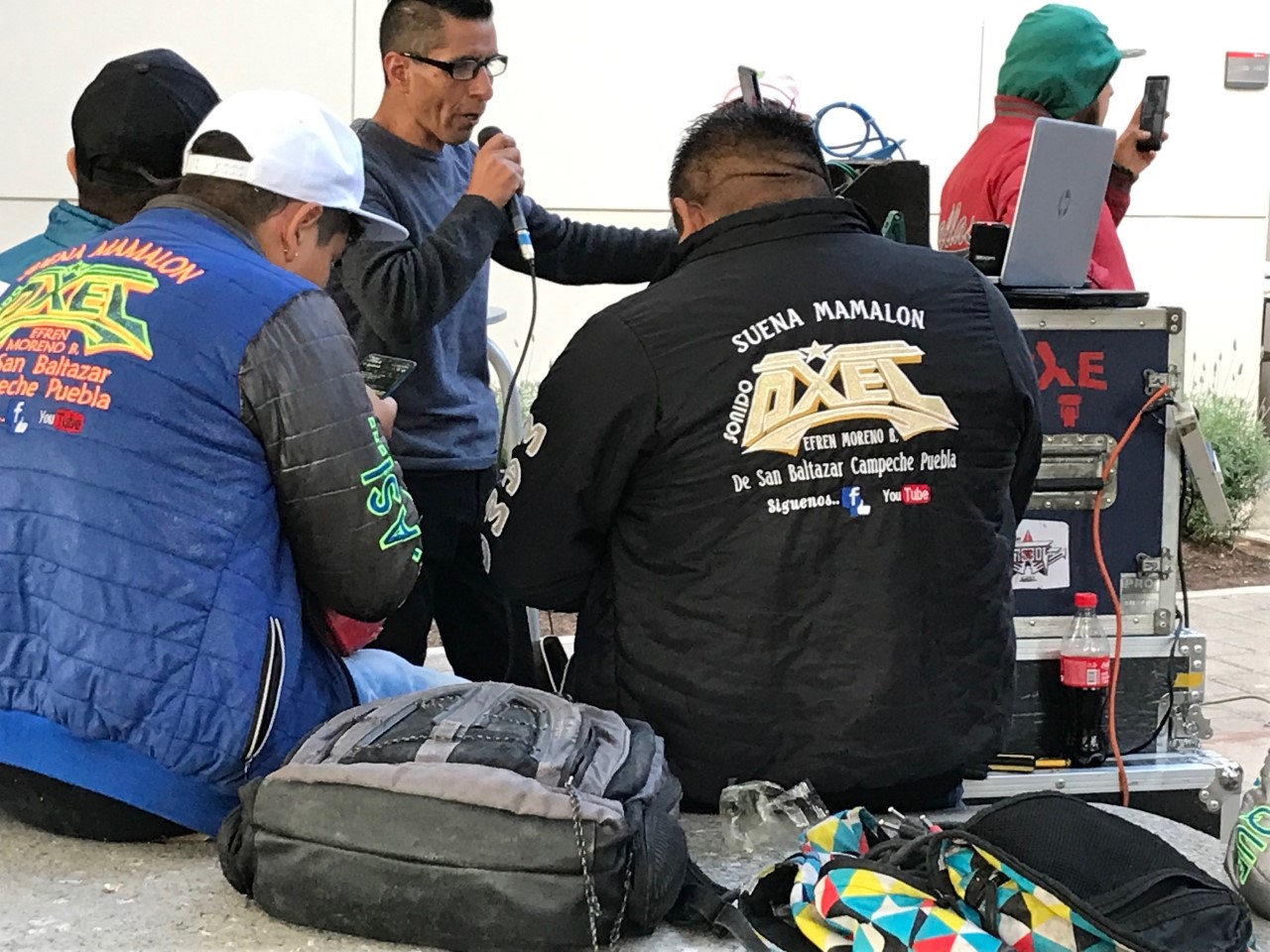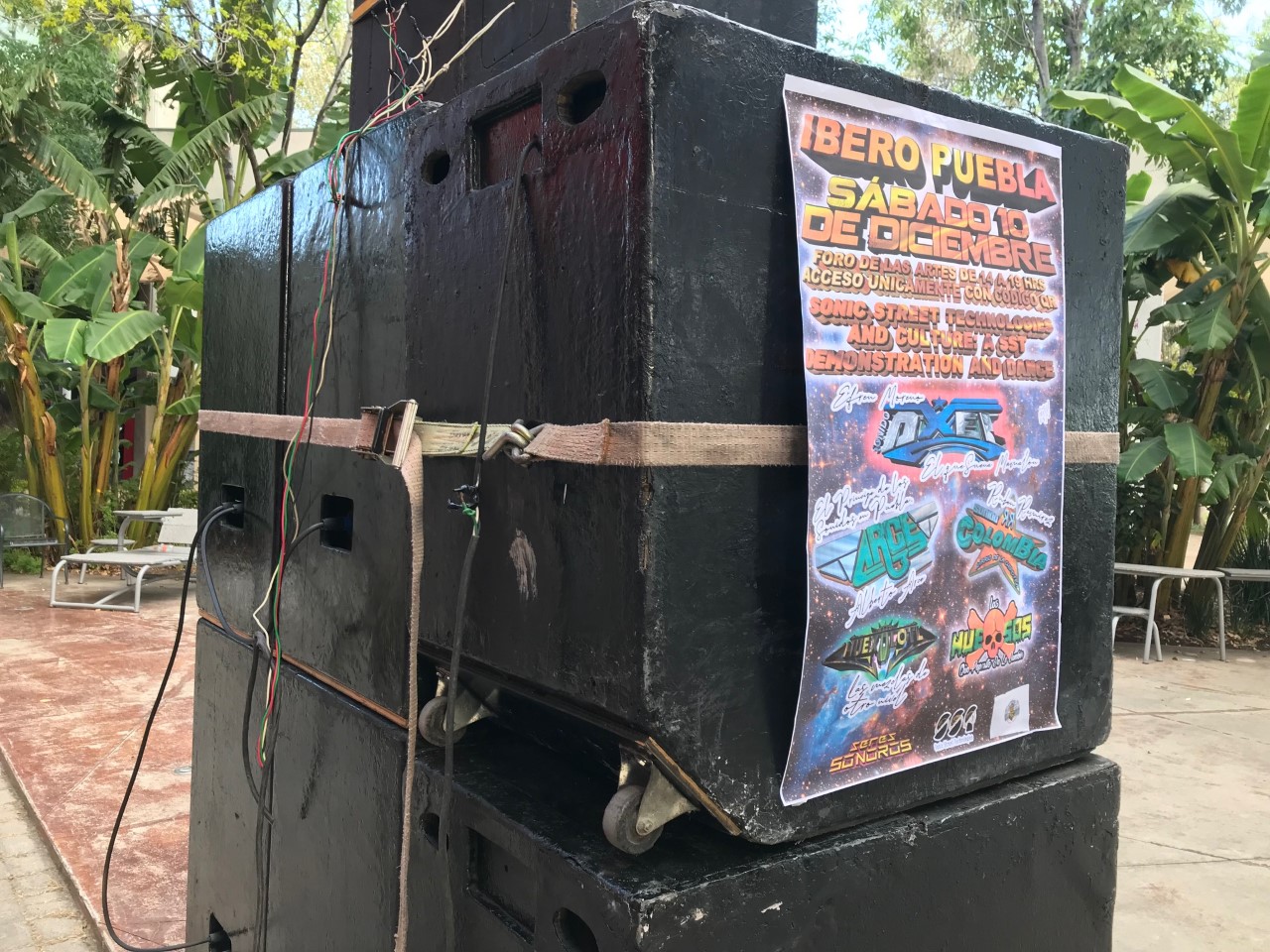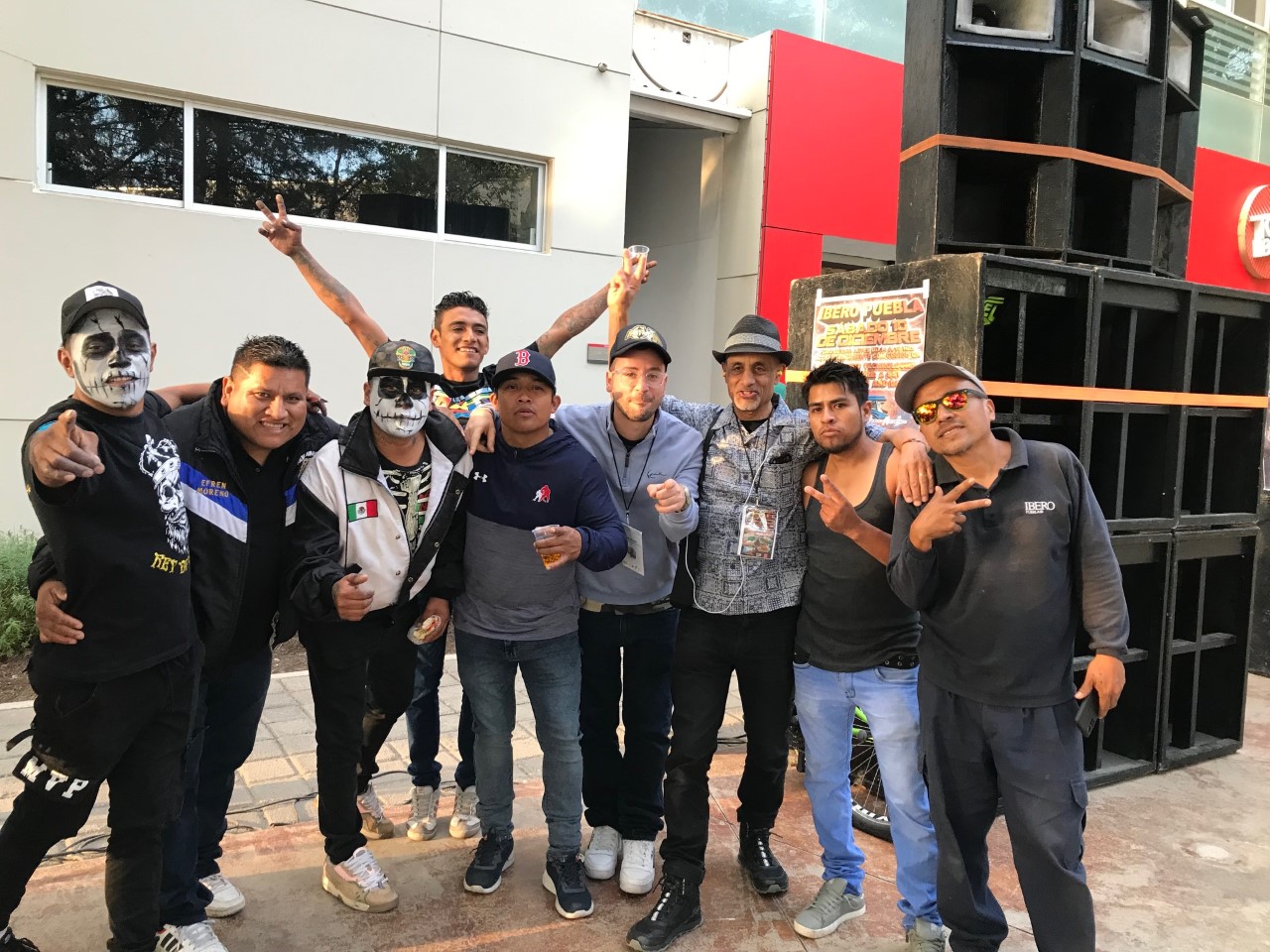SST at the 4S Conference in Cholula, Mexico
By Aadita Chaudhury
This last week, the Sonic Street Technologies team headed to Cholula, Mexico to be part of the Society for Social Studies of Science (4S) Conference at Cholula, Mexico. Each year, the 4S conference brings together researchers, practitioners and students of the discipline of science and technology studies, and configures and examines new ways of understanding the intersection between technology, society, and culture through sociopolitical and philosophical lenses.
The SST team’s presence at Cholula was important on several counts. This is the first time that the study of sound system cultures will interface publicly with the discipline of science and technology studies, with a specific focus on both academic and practitioner communities. This conference was also the site where a Mexican sonidero culture was invited in to create space for knowing and practicing the sound system ethos as part of conference activities. The discipline of science and technology studies is also home to theorists such as the late Prof. Trevor Pinch, who created groundbreaking work connecting sound studies to science and technology studies. As part of the conference panels that the SST team has organized, a colleague of Prof. Trevor Pinch, Prof. Steve Jackson of Cornell University paid an homage to Prof. Pinch’s work and its ongoing legacy.
On Saturday, December 10, several local sonideros participated in the dance that was organized by the SST team at the conference on the grounds of Universidad Iberoamericana Puebla.





Mexico is also an important aspect of the overall aims of the SST project. Mexico has been featured in the SST blog several times, most prominently through the work of researchers Linette Rivera and Mirjam Wirz, who have covered the presence of sonidero culture and its importance in Mexican urban life through their writing.
The SST Team’s official activities, with relevant abstracts, is presented below.
Sonic Street Technologies program at the Society for Social Studies of Science Meeting (4S), Universidad Iberoamericana Puebla, Cholula, Mexico
Sonic Street Technologies (SST) as a Means of Emergence and Survivance: Theory and Methods
Thu, December 8, 8:30 to 10:30am, Building D, D202
Chair: Prof. Julian Henriques, Goldsmiths, University of London
Aligning with the conference theme of “Reunion, recuperation, reconfiguration”, we explore how sonic street technologies (SST) serve as the nexus for material-semiotic interventions on emergent forms of community, knowledges and technology. The SST project aims to constitute a new field of enquiry into the relationships between culture, technology and power. It does this by researching the diverse ways in which standardised technologies are being re-purposed for musical entertainment and respite. SST across the planet have emerged in marginal communities in the Global South and elsewhere to become an essential part of the popular culture. Jamaican reggae sound systems, Brazilian aparelhagens, Mexican sonideros and Colombian picós are among the representatives of these ‘street’ (grass roots, independent, mobile) technologies.
Our presentations amplify the role that sonic street technologies have in supporting diasporic and/or marginalized communities and movements. We are interested in the situated embodied knowledges embedded in the shared public spaces where SST sessions are staged. This draws inspiration from ideas about sonic dominance and thinking through sound (Henriques 2011) and survivance (Vizenor 2008). We offer explorations of the sociotechnical imaginaries that are formed when auditory technologies and shared knowledges help to meet the needs of marginalised communities.
Sounds from the Global South: Actual and Abstract Machines
Prof. Julian Henriques, Goldsmiths, University of London
Case Studies in the research programme investigating particular SST give detail and depth, as a compliment to the breath of global geographical survey made public on the SST sonic map. Via our website we invite researchers to offer subjects or topics for a case study and offer guidance on what makes a suitable one, such as, a typical, exemplary, or unique SST, venue or piece of equipment. Beginning to emerge from our first ones in Huddersfield, Yorkshire in the north of England and Jamaica, is the way SST respond to similar economic and social circumstances – but in a different manner. This can be formulated in terms of the particular and abstract machines distinction where the abstract machine is what every SST requires – amplifiers, speakers, crew etc., whereas the actual is the particular cultural inflection that makes one type of STT such as Mexican sonideros different from Colombian picós, distinct from another. Case studies also allow us to understand the culture/ technology equation when tracing the adoption of a particular type of SST outside its originating geography, such as Jamaican reggae sound system in Italy or India. By providing particular examples of the relationship between the cultural, technological and economic factors the case studies show some of the ways in which the SST of the Global South have found solutions from which the Global North increasingly needs to adopt.
Sound systems as naturecultural assemblages
Aadita Chaudhury, Goldsmiths, University of London/York University, Canada
By situating the figure of the sound system in the materiality of international supply chains, one can elucidate how sound system culture, and its attendant communities, respond to the onslaught of forces that seek to suppress, erase or capture lifeways beyond hegemonic modes of embodiment and being, spatially and temporally. Reggae and dancehall sound systems represent the confluence of material and semiotic ingredients that are the historical and contemporary constituents of Caribbean lifeways. In an ongoing study of visual cultures of sound systems as they are represented on social media platforms such as Instagram, one often notes a pattern in visual representation of sound systems where there is a backdrop of biophysical and urban environments that root its presence in its milieu of origin. This repeated motif calls to attention how sound systems, like many other sonic apparatuses, are entities that are at the nexus of myriad naturecultural forces that reveal their entanglements with trans-local ecosystems. The material components of sound systems thus co-create an assemblage that is configured by the delicate negotiations between peoples and lands, especially in marginalized environments. This paper considers visual representations of sound systems, and the material ingredients of sound systems themselves, as part of an ongoing signifier of nature-culture relations in flux in accordance with flows of capital, both historically and contemporarily.
Mapping the SST Geographies: Ethics, Challenges and Findings
Brian D’Aquino, Goldsmiths, University of London
The SST Sonic Map aims to provide an extensive coverage of the different SST operating across the globe, while at the same time consolidating the idea of SST as a planetary, grassroots technological continuum. It does so by focusing on the three main elements which make an SST: the technological apparatus, the crew operating it, and the broader socio-cultural environment they are a part of. The dataset sustaining the map is currently being built by means of an online survey administered by SST Research Agents, who have been selected for their knowledge of particular SST scenes, as well as voluntarily contributed by SST professionals and aficionados. This presentation reports on the ongoing SST mapping process, discussing the research ethics behind it and highlighting the theoretical as well as practical challenges faced so far in the development of one of the most ambitious outputs of our research project. In building an interactive, community-open and freely navigable database, the scope is to give exposure to the diverse but equally vibrant street sonic cultures, allow comparison between different SST, foster mutual recognition and cross-fertilization between practitioners and aficionados from different backgrounds. The methodology is that of building non-extractive, healthy research relations within the different SST scenes in order to add value to what is currently happening out on the streets by using institutional status and financial resources to build local capacities.
Recognizing Knowledge, Thinking Otherwise
Liv Sovik, Universidad Federal do Rio de Janeiro
The Music of the Spheres, or musica universalis, was the way Johannes Kepler (1571-1630), based on the astronomy of Ptolemy and Pythagoras, imagined the distances between the sun, moon and other planets as being of harmonious proportions. For him, the planets vibrated silently but were still heard by the soul, as, perhaps, astrologers now understand the stars, in their conjunctions and movements, to create tides of feeling and tension. The vibrations of the spheres were abandoned as sources or objects of scientific inquiry. This panel brings musical vibration into play, by presenting three short films on sound systems from Brazil, Colombia and India that involve communities in their production and fruition. The films, commissioned for this panel, will be understood as manifestations of thought about the sound systems and their communities, and of ways of thinking through the experience of sound, that demand “a different understanding of rationality itself” (Henriques). A response to the films will draw out how this thought about and through sound systems may reconfigure academic practice and imaginaries about knowledge as it brings them closer to non logo- and Eurocentric knowledges of sound and music.
Sonic Street Technologies (SST) as a Means of Emergence and Survivance: Technological Genealogies and Diaspora
Thu, December 8, 11:00am to 1:00pm, Building D, D202
Chair: Prof. Julian Henriques, Goldsmiths, University of London
Aligning with the conference theme of “Reunion, recuperation, reconfiguration”, we explore how sonic street technologies (SST) serve as the nexus for material-semiotic interventions on emergent forms of community, knowledges and technology. The SST project aims to constitute a new field of enquiry into the relationships between culture, technology and power. It does this by researching the diverse ways in which standardised technologies are being re-purposed for musical entertainment and respite. SST across the planet have emerged in marginal communities in the Global South and elsewhere to become an essential part of the popular culture. Jamaican reggae sound systems, Brazilian aparelhagens, Mexican sonideros and Colombian picós are among the representatives of these ‘street’ (grass roots, independent, mobile) technologies.
Our presentations amplify the role that sonic street technologies have in supporting diasporic and/ or marginalized communities and movements. We are interested in the situated embodied knowledges embedded in the shared public spaces where SST sessions are staged. This draws inspiration from ideas about sonic dominance and thinking through sound (Henriques 2011) and survivance (Vizenor 2008). We offer explorations of the sociotechnical imaginaries that are formed when auditory technologies and shared knowledges help to meet the needs of marginalised communities.
Culture, power and technology in Jamaican sound system culture: past and present
Sonjah Stanley Niaah, University of the West Indies at Mona
Dennis Howard, University of the West Indies at Mona
Ashly Cork, University of the West Indies at Mona
Jamaica has been at the centre of the evolution of sonic technologies since the 1940s. Interestingly, those who have been at the heart of the cultural and technological inventions have not been those to map the history of SST evolution in Jamaica. Through the SST project, a collaborative relationship and data platform have been built to survey sound systems across nine decades of SST development in Jamaica. Using a combination of primary and secondary data, and in particular, the SST online survey, this presentation provides analysis of the culture-power-technology nexus. It does this from the engagement of partners to the initial findings including preliminary mapping of the evolution of Jamaican sound systems using select cases. The contemporary Jamaican sound system scene is compared to that of previous decades highlighting differences of emergence, association, inventiveness, business models and survival in a unique postcolonial political context. Ultimately, the presentation foregrounds the cultural influence of Jamaica through select case studies in each decade which exemplify styles of playing, and adaptation including to the COVID-19 pandemic.
Migration, diaspora and sites of experimentation: sound systems in France and its Afro-Caribbean genealogy
Jean-Christophe Avignon, Avignon Université
Maria Emilia Escamilla, Avignon Université
Sound system culture followed Caribbean immigration to England, and its influence on the techno sound systems that emerged from the acid-house movement is evident. In France, the young aficionados involved in the free party movement in the 1990s, audience and members of the sound systems crew, were barely aware of this history. The techno discourse has articulated a genealogy that focuses on the black musical production of Detroit techno and the European electronic avant-garde of the 1950s. It was during a second phase that a movement of dub sound systems emerged at the end of the 1990s, it positioned itself explicitly in the Afro-Caribbean genealogy of sound systems. It should also be noted that a number of actors in this movement come from the techno sound system and free party movement. By examining the trajectories of the enthusiasts, musicians and activists who follow this path, we can shed light on the differences between these two types of sonic assemblages, both in terms of material components (machinic assemblage) and expressive components (collective assemblage of enunciation).
Women in the Brazilian reggae scene: Feminine Hi-Fi
Daniella Pimeta, Feminine Hi-Fi
Andrea Lovesteady, Feminine Hi-Fi
Laylah Arruda, Feminine Hi-F
Emerging from the sound system scene in Brazil, Feminine Hi-Fi, an all-female sound system founded in 2016, promotes reggae with a particular orientation to the appreciation and presence of women in music. This film explores how Feminine Hi-Fi, consisting of Daniella Pimenta, Andrea Lovesteady and Laylah Arruda, engage with their communities not only through music but through sharing of their expertise via online talks and workshops and their record label, Feminine Hi-Fi records, first in Brazil dedicated exclusively to the development of the artistry of women in reggae. While foregrounding the work of Feminine Hi-Fi, this film shows the particularities of the challenges faced along gendered lines in the reggae scene in Brazil and the promises and perils of community-based infrastructures for artistic production and knowledge creation and sharing.
Sonic activism as a social and political practice: El Gran Latido, Colombia
Ricardo Vega, El Gran Latido
El Gran Latido Sound System of Bogotá, Colombia, was born in November 2017 under guidance from Channel One Sound System of the United Kingdom. This film takes us through how sound system communities collaborate across cultures and national borders to share knowledge and expertise to create new cultural scenes, and the key role of sound systems in social movements. While El Gran Latido promote roots & culture sound system in Colombia and South America, they are also deeply embedded in the social movements in their communities through their involvement in supporting strikes and projects in the different neighbourhoods of Bogotá as well as other cities in Colombia. In a short period of time, El Gran Latido have been out more than 100 times with the sound system amplifying the struggles of various marginalized communities throughout the country. The film highlights the key aspects of the intersection between sound system technology, culture and knowledge, performance and their historic and contemporary ties to social movements in Colombia and beyond.
Reconfiguring secular community spaces in India: Monkey Sound System
Dakta Dub, Monkey Sound System
Roy Dipankar, Monkey Sound System
Monkey Sound System is a Hyderabad, India-based sound system that is imagining sound system culture to play a role in reinvigorating public cultural spaces and life beyond the limitations of religion, caste or age. As Hindu nationalism entrenches further into Indian life, Monkey Sound System seeks to use its interventions to reconfigure not only how public spaces can be reconfigured to allow for inter-community bonding and solidarity amidst turbulent times. In trying to introduce sound system culture in India – and navigating the state bureaucracy in order to do so – this film shows how this young sound system connects contemporary social struggles in India and popular culture in India to its historic ties to reggae. This film shows us the journey Monkey Sound System take as a potent way to show how by engaging with practice and theory behind sound system cultures, they are imagining an Indian scene based on values of secularism, community and the dissolution of caste and religious barriers.
Sonido street technologies and culture: Workshop
Sat, December 10, 2:00 to 4:00pm, Building C, Aula Magna C201
Chair: Yael Gerson
Sonic Street Technologies (SST) approaches the sonido as Mexico’s unique mobile apparatus for playing recorded music to large crowds often in the streets on in public spaces. The central aspect of sonidera culture, sonidos are a key figure in Mexican popular culture and an example of what can be called a sonic street technology. We are delighted to be collaborating with Sonido Lunatico (TBC) (and sonidero from other groups) for this event.
The aim of this workshop is to demonstrate how a sonido actually works as an apparatus. Also important is how sonidera culture contributes to the multifaceted social imaginaries and technoscientific cultures that animate urban life in many parts of Mexico. We will explore how the technology itself is constituted using a culture of repurposing and repair that is inherent globally to sound system technologies at large. This event will be conducted in Spanish and English.
This workshop will begin in the late afternoon/evening of Thursday, December 8, 2022, at the 4S conference. It will constitute of three parts as follows.
- Deconstructing Sonida technology: in answer to the chairs questions the sonido operators/owners will be present with their equipment and demonstrate to the audience how the technology functions and the different constituent parts it is composed of, how the sound is created and how the process of creating a sonidera dance is undertaken.
- Sonidera culture and history: In this section, the sonido owners/operators will be asked to speak through larger social and cultural context, history and how their own individual sonidos are part of that, so that the audience is made aware of the connections between the technology itself and its role in the wider culture.
- Sonidera dance: The final part of the workshop would involve a dance where participants and audience members, including some members of the wider community are invited to experience sonidera culture direct with a dance.
Sonido street technologies and culture: a SST demonstration and dance
Sat, December 10, 4:30 to 6:30pm, Foro de lasArtes/Arts Forum, Foro de las Artes
Chair: Yael Gerson
